ZZ Plant Guide: Zamioculcas Care, Propagation, Toxicity, and More
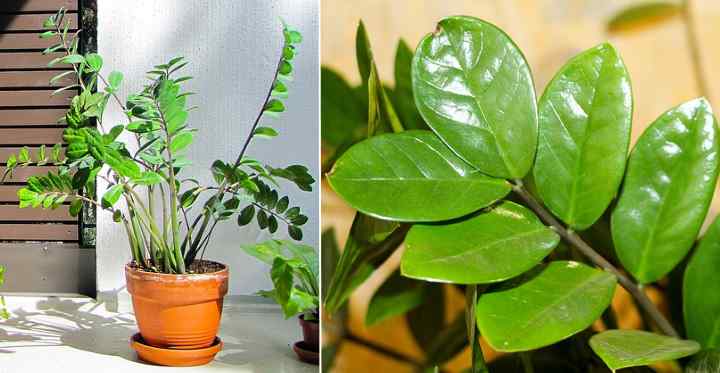
The ZZ plant is an excellent, easy-to-grow houseplant with long straight stems and glossy green leaves. Also called the Zizi plant, Zuzu plant, Zanzibar gem, steel plant, aroid palm, emerald palm, and eternity plant, this plant is perfect for growing indoors. ZZ plants don’t need a lot of light or water to keep their lush, green foliage shiny and glossy.
Zamioculas zamiifolia is the scientific name for the Zizi plant. The ornamental plant is native to eastern and southern Africa, where it can withstand heat and drought. The flowering plant grows well outdoors in temperatures above 59°F (15°C). It wasn’t until the 1990s that ZZ plants became popular evergreen houseplants.
How to care for ZZ plant: grow the Zamioculcas plant in well-draining potting soil and only water the plant when the soil is partly dry. Zizi plant thrives in plenty of light, away from direct sunlight, average room humidity, and a temperature between 65 and 75°F (18 – 24°C). Fertilize 3 or 4 times during the growing season with a diluted liquid houseplant fertilizer.
In this article, you will find out how to care for a ZZ plant. You will also learn how to propagate the popular houseplant and keep it free from pests and diseases.
What is the ZZ Plant (Zamioculcas zamiifolia)?
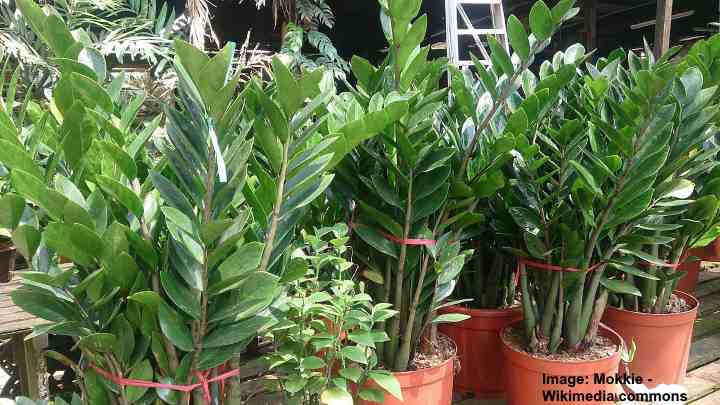
ZZ plant (zamioculcas zamiifolia) is a popular hardy houseplant
There is only one species of plant in the genus Zamioculcas. The most common type of ZZ plant is the green-leaved herbaceous plant with its shiny foliage. The Raven ZZ plant is of the same species but it has dark purple, almost black foliage.
ZZ plants grow to between 18” and 23.5” (45 – 60 cm) tall. The thick stems grow from a succulent rhizome that looks like a small potato. This rhizome is the reason why emerald palms can survive months without water.
Each thick succulent stem on the ZZ plant has pinnate shaped leaflets that have a fleshy texture. These shiny leaves grow alternately on the stem and are around 2.8” – 6” (7 – 15 cm) long. Botanically speaking, each stem is a leaf that contains pairs of leaflets.
To create a bushier appearance, you can plant a few rhizomes together.
ZZ plants also produce flowers; however, these are small and not very showy. The little “flowers” are a type of spadix – this is a leaf-like bract surrounding a soft spike covered in tiny flowers. They appear near the base of the stems from mid-summer until early fall.
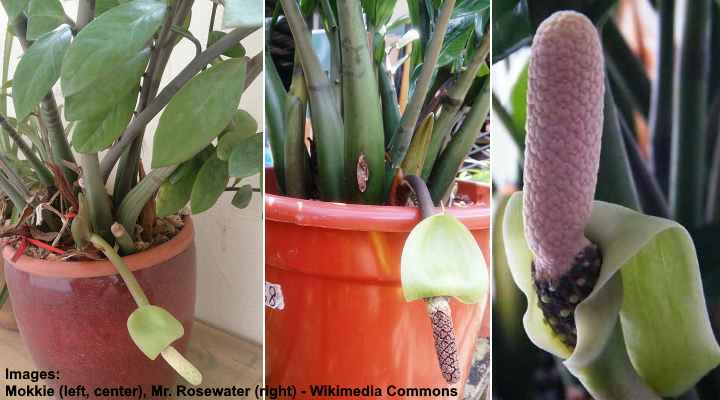
In the picture: ZZ plant flower
Keeping a Zanzibar gem plant in your home or office may also help clean the air. Some reports suggest that the leaves help to filter out airborne toxins and pollutants.
ZZ Plant Care Summary
There are very few requirements when it comes to caring for a “zee zee” plant. Average room temperatures and house humidity create the perfect growing environment. They are also hardy indoor plants that are resistant to disease.
Although the plant grows best in bright, indirect sunlight, bright light isn’t essential. The Zizi plant will grow well in a shady corner, under fluorescent lights, or on a sunny windowsill. Caring for a Zanzibar gem is easy because it doesn’t need a lot of water. In fact, the hardy houseplant seems to thrive on neglect.
ZZ Plant (Zamioculcas) Care
ZZ plants have modest requirements when it comes to proper care. However, there are a few care tips to remember to ensure that your Zanzibar gem plant thrives.
Right Type of Soil for ZZ Plants
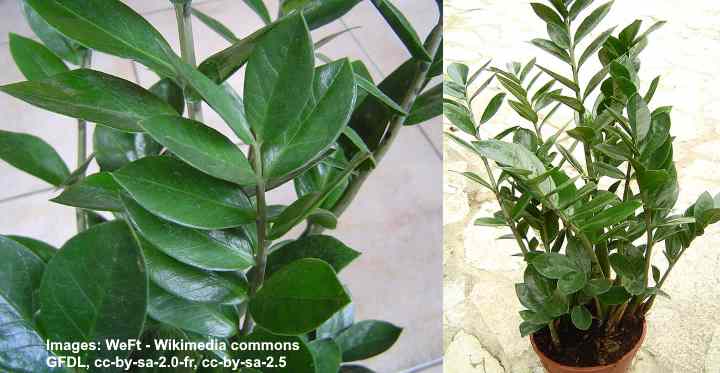
ZZ plant soil should be well-draining and shouldn’t be excessively watered
To care for your ZZ, you should plant it in a pot containing well-draining potting soil. The best way to create loamy soil for a ZZ plant is to mix a 1-part potting mix with 1-part perlite or horticultural sand.
Because ZZs have succulent qualities, cactus potting mix is also an excellent choice to grow this indoor plant.
Your Zizi plant hates excess moisture, so along with the appropriate soil mix, your pot needs to have drainage holes. You can increase drainage flow by putting a layer of clay pebbles at the bottom of the container.
A proper soil mix ensures that the soil never becomes too soggy. Excessively damp soil results in root rot and weak growth. At the end of the article, you can find out how to spot signs of damaged or diseased ZZ plant roots.
Lighting Requirements for ZZ (Zizi) Plants
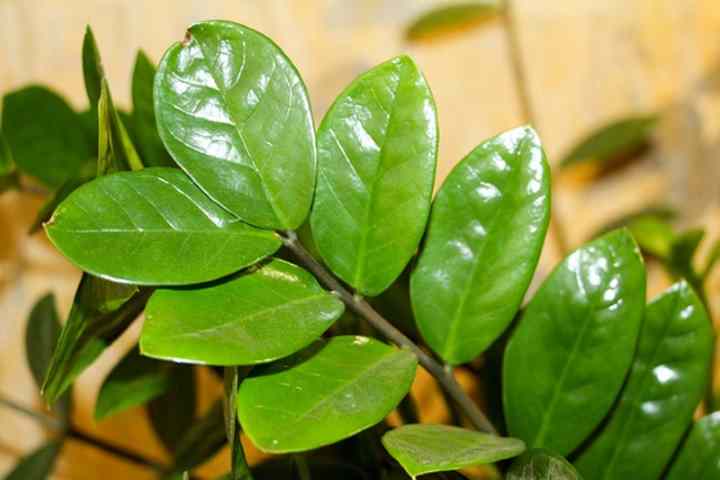
ZZ plant grows best in bright, indirect sunlight
To care for your Zamioculcas, you need to make sure it gets plenty of light. The best location is near a window if you want your houseplant to grow fast.
If you decide to put it on a windowsill, make sure it is on an east- west- or north-facing window. Some early morning or late evening sun is fine, but too much direct sunlight during the day can cause leaf burn. On a south-facing windowsill, the plant should be behind sheer curtains.
Your emerald palm should be just fine in low-light conditions. Even if it doesn’t get natural sunlight, it will still grow well indoors under artificial light such as in office buildings.
How to Water Your ZZ Plant (Zamioculas)
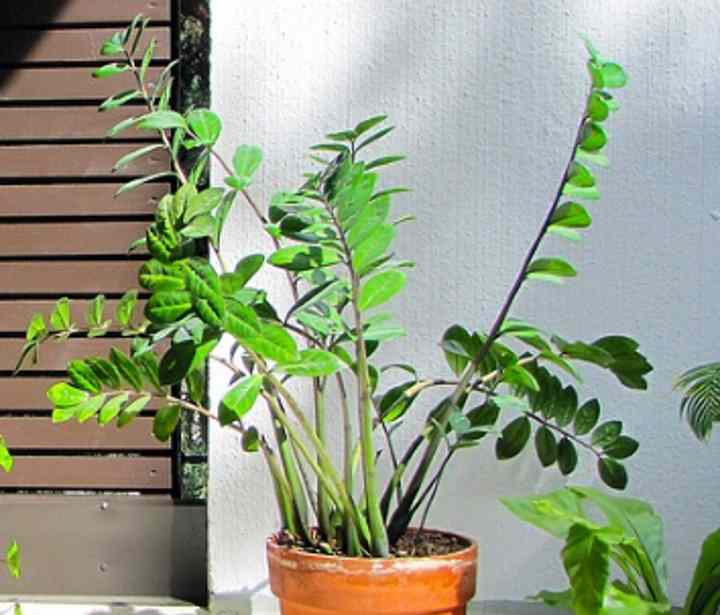
ZZ plant doesn’t required frequent watering
The great thing about having a ZZ plant at home is that you hardly have to water it. The key to knowing when to water a ZZ is when the top layer of the soil is dry. Every week or so, check to see when the top 1” (2.5 cm) has dried out.
The best watering tip to care for your ZZ plant is to thoroughly water the soil until the water drains out the bottom. You can then almost forget about watering for another 2 weeks or so.
The type of soil you need for a Zanzibar gem plant should be on the dry side. So, don’t let the container sit in a tray of water. This will cause the soil to soak up too much moisture, and you will end up with a ZZ plant that has yellow leaves and stunted growth.
The succulent leaves and rhizomes mean that your ZZ can go for longer without water than most other houseplants, such as nerve plants. However, regular watering will ensure that your plant’s foliage keeps its shiny glossy appearance.
ZZ Plant (Steel Plant) Humidity Requirements
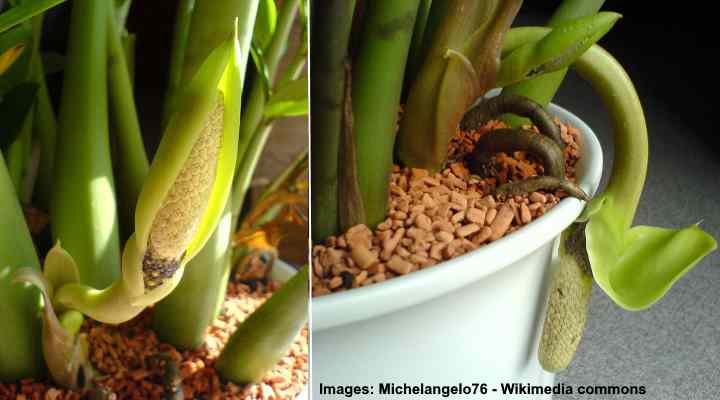
ZZ plant flowers and new growth
Looking after a steel plant in the home is easy because average room humidity is perfect for healthy growth. Some houseplants such as polka dot plants require misting every day, but not your ZZ plant.
The only time humidity becomes a concern with a steel plant is when you’ve got the household heating on in winter. Central heating can dry out the air in your home. During winter, you should mist your houseplants every so often. You will know the leaves need some moisture when their tips turn brown.
ZZ Plant (Emerald Palm) Temperature
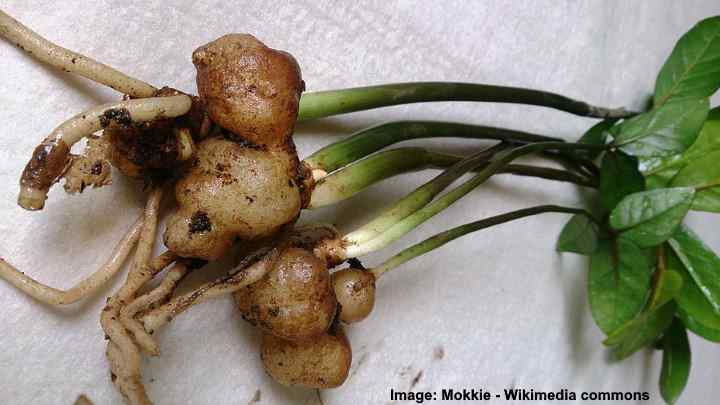
In the picture: ZZ plant roots
If you want your emerald palm to look its best, keep your room at an even temperature. The best range of temperature for healthy growth is between 65 and 75°F (18 – 24°C).
If you enjoy warm summers, you can put your Zamioculas plants outside. A ZZ plant in a container can add some beautiful greenery to a balcony, deck, patio, or other areas. Just make sure that it is not in direct sunlight all day, and bring it inside as soon as the temperature drops.
Fertilizer for ZZ Plants (Aroid Palms)
Generally, you don’t need to feed your Zanzibar plant to keep it healthy. The plant is a slow-growing type of houseplant with few nutrient requirements. If you use good-quality potting soil, your aroid palm should get all the nutrients it needs.
You can use fertilizer to help boost plant growth during spring and summer. Feed the ZZ plant 4 times a year using a balanced fertilizer for houseplants. Do this after watering. Flushing out the soil helps prevent too many mineral salts from building up which causes leaf burn.
How to Prune a ZZ Plant
There is no need to prune a healthy zee zee plant. Usually, the only time to take the pruning shears to it is to reduce the size of a large ZZ plant. In this case, you can prune the stems to the required height. Just remember that pruning doesn’t stimulate faster growth.
You should also prune off leaves that have turned yellow. Yellowing leaves can occur, especially at the base of the stem, if you are over-watering the houseplant.
The good news is that the occasional yellow leaf is probably nothing to worry about. As new leaves appear, old ones turn yellow and drop off. If you are caring properly for your Zanzibar gem, the odd yellow leaf is entirely normal.
ZZ Plant Repotting
At some point, your zizi plant will need repotting. Re-potting in a larger container gives roots more room to grow and helps water drain better. Because your houseplant doesn’t grow fast, you shouldn’t need to repot very often.
The best time to repot your Zamioculcas plant is in spring when it starts growing. Choose a container with drainage holes that is 2” (5 cm) wider than the current one.
Gently remove the stems and rhizomes from the pot and shake off excess soil. If you are repotting due to waterlogged soil and root rot, cut off any damaged roots. Fill a new container half full with loamy potting mix. Put your ZZ plant in and fill with the remaining potting mix. Water thoroughly.
ZZ Plant Flowers
The only time an emerald palm flowers is when it grows outdoors. Even then, the flowers are small and insignificant and grow at the base of the plant hidden behind foliage.
The flowers are a type of spathe which is standard on many other aroid plants in the family Araceae. Similar, but showier flowers are found on peace lilies.
ZZ Plant (Eternity Plant) Pests and Diseases
Caring for an eternity plant couldn’t be easier when you consider it is resistant to pests and diseases. Usually, any of the common signs of disease, such as yellow leaves, are due to watering issues.
Watering a ZZ plant can cause the rhizomes to become soggy and rotten. However, this is entirely controllable by cutting back on watering.
In rare cases, pests such as aphids can affect your zizi plant. This only usually happens if your ZZ is outside in a container. It rarely happens with indoor zizis. The tiny bugs cause small yellow spots to appear on the leaves. Another sign of an aphid infestation is sticky fluid on the foliage.
Use a mixture of liquid soap, neem oil, and water to get rid of the mites.
ZZ Plant (Zamioculcas) Propagation
Propagating a ZZ plant is useful because the plant helps purify the air in homes and offices. You can easily propagate a healthy steel plant by taking stem cuttings, a leaf cutting, or using the soil-division method.
Propagating a ZZ plant in water
To grow a new ZZ from a stem, cut a healthy stem about 6” – 12” (15 – 30 cm) from the top of the plant. Place the stem in a jar of water and put the jar in a warm, bright place. Replace the water every 2 – 3 days.
When you notice roots growing from the base of the stem, you should plant the stem in potting mix.
Propagating a Zanzibar gem plant from leaves
The leaf propagation method is the easiest way to grow a new ZZ. Cut a healthy leaf off the stem, and let it dry for a few hours. Place the leaf directly in moist potting soil so that about 1” (2.5 cm) of soil covers the leaf. Keep the small pot in a warm place and water occasionally.
It may take some time for roots to develop, so patience is necessary.
Using rhizome division to propagate a ZZ plant
If you have a large ZZ plant with a few rhizomes, you can divide the tubers to get a new houseplant. Use a knife or cutter to separate the rhizome into 2 or 3 parts so that there is at least one leaf stem on each. Then replant the individual tubers in new pots with fresh potting mix that is well-draining.
Is ZZ Plant (Zamioculcas) Poisonous?
ZZ plants contain poisonous substances that can harm pets (such as cats and dogs) and humans. The toxic substances are found in the plant’s sap. So, you should avoid touching the sap when cutting or pruning it. Also, keep the plant away from kids or pets to prevent them from chewing on the leaves.
Most aroid plants from the Araceae family contain calcium oxalate. According to a government website, chewing or swallowing any part of the Zamioculcas plant can cause pain, burning, or swelling. If you notice any of these symptoms, seek medical advice immediately. (1)
Getting the plant’s sap on your skin can also result in contact dermatitis if you have sensitive skin.
The plant leaves and stems are safe to touch and don’t pose any health risk. There certainly no evidence that ZZ plants or their flowers cause cancer. In fact, a 2015 study reported that, despite its reputation for being toxic, “little or no systematic evidence exists to support this claim.” (2)
Even though it is on lists of poisonous houseplants, there are many reasons for having a ZZ plant at home or at work. Some studies show that Zamioculcas zamiifolia is one of the most efficient houseplants for removing certain toxins from the air. (3)
Related articles:
